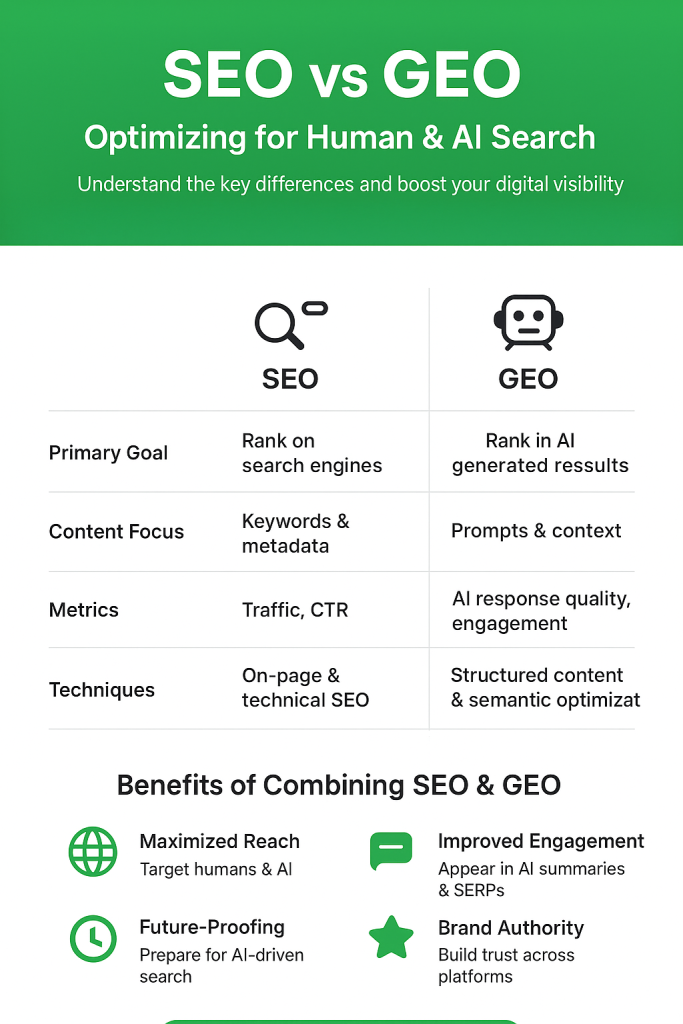SEO vs GEO: The Ultimate Guide to Winning at Search in 2025
The digital marketing landscape is experiencing a seismic shift. For over two decades, Search Engine Optimization (SEO) has been the undisputed king, a complex art form dedicated to securing the top spot on Google’s search results. But the rise of powerful AI, exemplified by Google’s AI Overviews and platforms like ChatGPT, has given birth to a new and critical discipline: Generative Engine Optimization (GEO).
What is SEO (Search Engine Optimization)? The Bedrock of Visibility
SEO is the foundational practice of optimizing a website and its content to rank higher in traditional search engine results pages (SERPs). The primary goal is to drive organic traffic by aligning your content with what human users are actively searching for. Think of SEO as the art of being the most relevant, authoritative, and user-friendly result on a list of options.
Core Pillars of Modern SEO
Modern SEO success in 2025 hinges on a holistic approach that goes far beyond just keywords:
- High-Quality, Helpful Content: The number one ranking factor. This means content must be original, comprehensive, accurate, and, most importantly, satisfy the user’s search intent. Google’s E-E-A-T (Experience, Expertise, Authoritativeness, and Trustworthiness) guidelines are paramount here.
- On-Page SEO: The technical optimization of individual page elements, including keyword-optimized title tags, meta descriptions, a logical header structure (H1, H2, H3), and clean, descriptive URLs.
- Off-Page SEO & Backlinks: Building authority through high-quality backlinks from reputable and relevant websites remains a powerful trust signal for Google.
- Technical SEO: Ensuring a flawless user experience through fast page speeds (Core Web Vitals), mobile-friendliness, secure HTTPS, and a crawlable site structure.
- User Experience (UX): Factors like how long users stay on your page, whether they find what they need, and the ease of navigation are all implicit ranking signals.
What is GEO (Generative Engine Optimization)? The New Frontier of Answers
Generative Engine Optimization (GEO) is the practice of optimizing content to be understood, trusted, and cited by AI models in their generated answers. The goal of GEO is not to get a user to click a link, but to have your information, brand, and data featured directly within the AI’s response, whether in an AI Overview, a chatbot conversation, or a voice assistant reply.
Think of GEO as establishing your content as a canonical source of truth for machines.
The Core Components of GEO
GEO requires a shift in focus from ranking signals to information quality and structure:
- Entity Optimization: Clearly defining key entities (people, places, concepts, brands) within your content so AI can understand who you are and what you’re an expert in. Consistent information across all digital platforms is crucial.
- Structured Content & Data: Using clear, logical formatting like lists, tables, and concise Q&A sections. Implementing advanced Schema markup to explicitly label your content for machines is vital.
- Factual Accuracy & Citations: AI models are trained to prioritize verifiably accurate information. Citing authoritative sources, including recent studies and statistics, and including expert quotes signals trustworthiness.
- Passage Clarity: Breaking down content into short, self-contained passages that can be easily extracted and repurposed by an AI without losing context.
SEO vs. GEO: Key Differences at a Glance
| Aspect | SEO (Search Engine Optimization) | GEO (Generative Engine Optimization) |
|---|---|---|
| Primary Target | Human users scanning a list of search results. | AI models synthesizing information into a direct answer. |
| Core Goal | Earn a click and drive traffic to your website. | Become a cited source within the AI-generated response. |
| Key Metrics | Keyword Rankings, Organic Traffic, Click-Through Rate (CTR). | Citation Frequency, Brand Mentions, Visibility in AI Overviews. |
| Content Focus | Narrative flow, keyword relevance, user engagement. | Factual accuracy, structured data, passage clarity, entity definition. |
| Authority Signals | High-quality backlinks, domain authority. | Authoritative citations, entity recognition, data verifiability. |

Why You Can't Choose One: The Power of an Integrated Strategy
The most crucial takeaway is that the “SEO vs. GEO” debate presents a false choice. A robust digital strategy in 2025 and beyond doesn’t replace SEO with GEO; it integrates them.
Your SEO efforts build the domain authority and topical relevance that AI models use as a foundational signal of trust. A high-ranking, well-regarded page is more likely to be considered a reliable source for an AI-generated answer. In turn, GEO techniques make that trusted content perfectly formatted for AI consumption.
SEO builds the authority, and GEO delivers the answer.
Challenges & Considerations in the New Search Era
Navigating this hybrid landscape isn’t without its obstacles. Understanding the distinct challenges of both SEO and GEO allows for a more robust and realistic strategy.
SEO Challenges:
- Intense Competition: Ranking for high-value keywords is more competitive than ever, requiring significant and sustained effort.
- Algorithm Volatility: Google’s frequent algorithm updates can cause rankings to fluctuate unexpectedly, demanding constant adaptation.
- Resource Demands: Effective SEO, especially link-building and technical optimization, can be a time-consuming and costly endeavor.
GEO Challenges:
- AI’s “Black Box” Nature: The exact criteria AI models use to select and cite sources are not fully transparent, making optimization a process of educated inference.
- Rapid Model Evolution: Generative AI models are evolving at an incredible pace. What works today might need adjustments tomorrow.
- Balancing Act: Crafting content that is structured for machine readability without sounding robotic and sterile for human readers is a key challenge.
Practical Tips for an Integrated SEO + GEO Strategy 💡
Adopting a hybrid approach means making tactical adjustments to your content creation process. Here are actionable tips to get started today.
- Embrace “Answer-First” Content: Structure your articles to provide a direct, concise answer to the core question in the first paragraph. Use the rest of the article to elaborate with details, data, and context.
- Think in Questions: Use your headers (H2s, H3s) to pose the questions your audience is asking. This optimizes for both Google’s “People Also Ask” snippets (SEO) and direct AI queries (GEO).
- Structure Everything with Schema: Go beyond basic schema markup. Implement
FAQPage,HowTo, andArticleschema to explicitly label your content’s purpose for search engines and AI. This is one of the most powerful GEO techniques. - Prioritize E-E-A-T Signals: Double down on Expertise, Experience, Authoritativeness, and Trustworthiness. Create detailed author bios, cite reputable sources, and showcase real-world experience. This is a top-tier ranking factor for both humans and AI.
- Build Topical Authority: Instead of writing one-off articles, create content clusters around your core topics. Linking these articles together demonstrates comprehensive expertise to search engines and provides rich, contextual data for AI models.
Future Trends: Where Search is Headed 🚀
The line between traditional search and generative AI will continue to blur. Here’s what to expect in the near future.
- AI as the Primary Interface: For many queries, especially informational ones, users will interact with an AI-generated summary first and traditional search results second, if at all.
- Hyper-Personalized Results: AI will enable search results that are tailored not just to the query, but to the individual user’s context, history, and intent.
- The Rise of “Zero-Click” Authority: Success will be measured less by clicks and more by brand presence and citations within AI answers. Being the trusted source cited by AI will become a primary marketing goal.
Ultimately, businesses that successfully integrate SEO with GEO are not just optimizing for a search engine; they are positioning themselves as the authoritative answer for their industry, no matter how a user chooses to ask the question.
Frequently Asked Questions: SEO vs. GEO
Q1: Is GEO replacing SEO?
No, GEO is not replacing SEO. Think of it as an evolution. GEO builds upon the authority that strong SEO establishes. SEO gets your content noticed by search engines and users, building the trust and relevance needed for AI models to consider it a credible source. GEO then formats that trusted content so AI can easily understand and cite it. You need both to succeed.
Q2: Do I need a separate strategy for GEO?
You need an integrated strategy, not a separate one. The best approach is to weave GEO principles into your existing SEO workflow. This means enhancing your authoritative content with structured data, clear Q&A formatting, and entity optimization. It’s about adding a new layer of optimization to what you already do.
Q3: What is the single most important factor for GEO?
While structured data is technically crucial, the single most important factor is verifiable factual accuracy. AI models are being trained to combat misinformation, so they prioritize content that is demonstrably true, well-sourced, and aligns with established expert consensus. Your E-E-A-T (Experience, Expertise, Authoritativeness, and Trustworthiness) is the foundation of successful GEO.
Q4: How can a small business start with GEO?
The easiest and most effective way for a small business to start with GEO is by optimizing their local business information and creating a detailed FAQ page.
• Local SEO & Entity: Ensure your business Name, Address, and Phone number (NAP) are perfectly consistent everywhere online. This solidifies your business as a known entity.
• FAQ Page: Create a page that answers the top 10-15 questions your customers ask. Use clear question-and-answer formatting and add FAQPage schema. This is a powerful way to get featured in both traditional snippets and AI answers.
Q5: How do you measure the ROI of GEO?
Measuring GEO is an emerging field, but key metrics include:
Citation Frequency: Tracking how often your brand or website is mentioned as a source in AI Overviews for your target keywords.
Brand Mentions: Monitoring for an increase in mentions of your brand name in online conversations, which can be an indirect result of AI-driven discovery.
Zero-Click Search Impact: Analyzing whether a drop in clicks for a top-ranking keyword corresponds with your content being featured in an AI answer. While traffic might decrease, the increase in brand authority can be a valuable trade-off.
Conclusion
SEO remains essential for driving traffic and maintaining search engine visibility. However, the rise of generative AI makes GEO equally important. By understanding both strategies and integrating them into your content marketing, you can ensure maximum reach, engagement, and future-proof visibility in both traditional and AI-driven search environments.
Audit your current SEO strategy and begin implementing GEO practices today to stay ahead in the AI-powered digital landscape.
Author

Devinda Chinthaka
Digital marketing expert with 15+ years of experience in SEO, social media, paid ads, and digital strategies.
